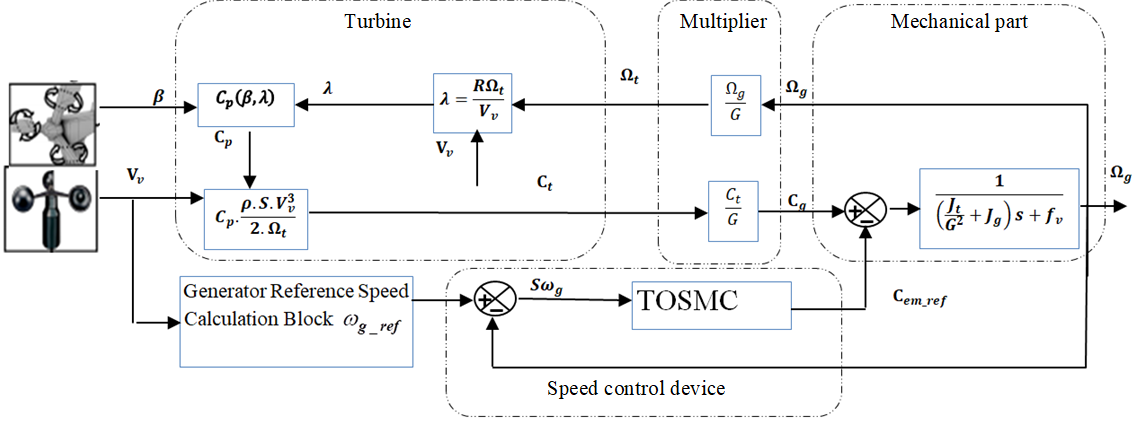Comparative analysis between classical and third-order sliding mode controllers for maximum power extraction in wind turbine system
DOI:
https://doi.org/10.20998/2074-272X.2025.3.03Keywords:
wind turbine, maximum power point tracking, third-order sliding mode control, variable speed wind turbinesAbstract
Introduction. Maximizing power extraction in wind energy conversion systems is crucial for efficiency but remains a challenge due to rapid wind speed variations and the high inertia of the generator. Conventional controllers, such as the PI controller, struggle to maintain optimal performance under such dynamic conditions, leading to suboptimal power capture and increased system oscillations. The goal of this study is to enhance the efficiency of wind turbine systems by applying linear and nonlinear controllers in a maximum power point tracking (MPPT) strategy. This approach focuses on improving generator speed regulation and power conversion performance. Methods. A comparative analysis is conducted using three different control strategies: third-order sliding mode control (TO-SMC), classical sliding mode control (SMC) and PI control. These controllers are implemented in the generator speed loop of a wind turbine system, and their performance is evaluated through MATLAB/Simulink simulations. The assessment focuses on key performance metrics such as tracking accuracy, total harmonic distortion (THD), response time, and system stability. Results. The simulation results confirm that all controllers achieve MPPT, but with varying levels of effectiveness. The TO-SMC outperforms both SMC and PI controllers, offering higher efficiency, reduced chattering, better disturbance rejection, and lower THD (reduced from 73 % in SMC to 68.09 %). Additionally, TO-SMC significantly improves dynamic response, reducing overshoot and enhancing system stability. Originality. This study introduces a TO-SMC for MPPT in wind turbine systems, demonstrating its superiority over conventional control techniques. The findings highlight its ability to maintain optimal power extraction even under rapid wind variations, making it a promising solution for advanced wind energy systems. Practical value. By improving power quality, reducing system oscillations, and enhancing overall wind turbine efficiency, the proposed TO-SMC contributes to the reliable integration of wind energy into power grids. These advancements can benefit renewable energy operators, power system engineers, and researchers seeking efficient and robust MPPT solutions for wind turbines. References 13, figures 11.
References
Rapport annuel mondial sur l'énergie - Edition 2024. Available at: https://kpmg.com/fr/fr/insights/energie/rapport-annuel-energie-edition-2024.html (Accessed: 30 July 2024). (Fra).
Nair R., Gopalaratnam N. Stator Flux Based Model Reference Adaptive Observers for Sensorless Vector Control and Direct Voltage Control of Doubly-Fed Induction Generator. IEEE Transactions on Industry Applications, 2020, vol. 56, no. 4, pp. 3776-3789. doi: https://doi.org/10.1109/TIA.2020.2988426.
Hassainia S., Ladaci S., Kechida S., Khelil K. Impact of fractional filter in PI control loop applied to induction motor speed drive. Electrical Engineering & Electromechanics, 2022, no. 5, pp. 14-20. doi: https://doi.org/10.20998/2074-272X.2022.5.03.
Muthukaruppasamy S., Dharmaprakash R., Sendilkumar S., Parimalasundar E. Enhancing off-grid wind energy systems with controlled inverter integration for improved power quality. Electrical Engineering & Electromechanics, 2024, no. 5, pp. 41-47. doi: https://doi.org/10.20998/2074-272X.2024.5.06.
Kerboua A., Abid M. Hybrid fuzzy sliding mode control of doubly-fed induction generator speed in wind turbines. Journal of Power Technologies, 2015, vol. 95, no. 2, pp. 126-133.
Mousa H.H.H., Youssef A.-R., Mohamed E.E.M. Variable step size P&O MPPT algorithm for optimal power extraction of multi-phase PMSG based wind generation system. International Journal of Electrical Power & Energy Systems, 2019, vol. 108, pp. 218-231. doi: https://doi.org/10.1016/j.ijepes.2018.12.044.
Abdullah M.A., Yatim A.H.M., Chee Wei Tan. A study of maximum power point tracking algorithms for wind energy system. 2011 IEEE Conference on Clean Energy and Technology (CET), 2011, pp. 321-326. doi: https://doi.org/10.1109/CET.2011.6041484.
Bourouina A., Djahbar A., Chaker A., Boudjema Z. High Order Sliding Mode Direct Torque Control of a DFIG Supplied by a Five-Level SVPWM Inverter for the Wind Turbine. Elektrotehniski Vestnik, 2018, vol. 85, no. 5, pp. 263-270.
Saidi Y., Mezouar A., Miloud Y., Yahiaoui M., Benmahdjoub M.A. Modeling and adaptive power control-designed based on tip speed ratio method for wind turbines. Przeglad Elektrotechniczny, 2019, vol. 95, no. 6, pp. 40-46. doi: https://doi.org/10.15199/48.2019.06.08.
Oualah O., Kerdoun D., Boumassata A. Comparative study between sliding mode control and the vector control of a brushless doubly fed reluctance generator based on wind energy conversion systems. Electrical Engineering & Electromechanics, 2022, no. 1, pp. 51-58. doi: https://doi.org/10.20998/2074-272X.2022.1.07.
Oualah O., Kerdoun D., Boumassata A. Super-twisting sliding mode control for brushless doubly fed reluctance generator based on wind energy conversion system. Electrical Engineering & Electromechanics, 2023, no. 2, pp. 86-92. doi: https://doi.org/10.20998/2074-272X.2023.2.13.
Benbouhenni H., Driss A., Lemdani S. Indirect active and reactive powers control of doubly fed induction generator fed by three-level adaptive-network-based fuzzy inference system – pulse width modulation converter with a robust method based on super twisting algorithms. Electrical Engineering & Electromechanics, 2021, no. 4, pp. 31-38. doi: https://doi.org/10.20998/2074-272X.2021.4.04.
Ahmed S., Ahmed A., Mansoor I., Junejo F., Saeed A. Output Feedback Adaptive Fractional-Order Super-Twisting Sliding Mode Control of Robotic Manipulator. Iranian Journal of Science and Technology, Transactions of Electrical Engineering, 2021, vol. 45, no. 1, pp. 335-347. doi: https://doi.org/10.1007/s40998-020-00364-y.

Downloads
Published
How to Cite
Issue
Section
License
Copyright (c) 2025 A. Bourouina, R. Taleb, G. Bachir, Z. Boudjema, T. Bessaad, H. Saidi

This work is licensed under a Creative Commons Attribution-NonCommercial 4.0 International License.
Authors who publish with this journal agree to the following terms:
1. Authors retain copyright and grant the journal right of first publication with the work simultaneously licensed under a Creative Commons Attribution License that allows others to share the work with an acknowledgement of the work's authorship and initial publication in this journal.
2. Authors are able to enter into separate, additional contractual arrangements for the non-exclusive distribution of the journal's published version of the work (e.g., post it to an institutional repository or publish it in a book), with an acknowledgement of its initial publication in this journal.
3. Authors are permitted and encouraged to post their work online (e.g., in institutional repositories or on their website) prior to and during the submission process, as it can lead to productive exchanges, as well as earlier and greater citation of published work.




